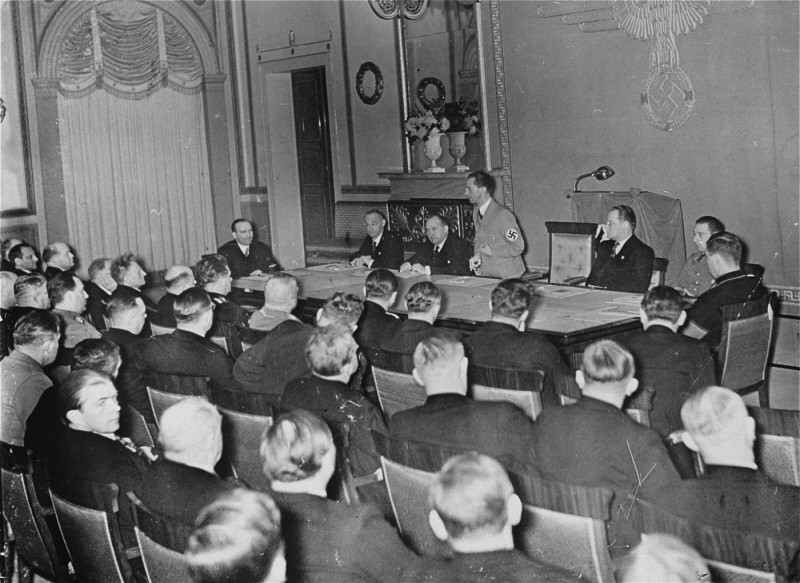
Culture in the Third Reich: Overview
National Socialism (Nazism) represented much more than a political movement. The Nazi leaders who came to power in January 1933 wanted more than just political authority. They wanted to change the cultural landscape: to promote what they considered to be traditional “German” and “Nordic” values, to remove Jewish, “foreign,” and “degenerate” influences, and to shape a racial community which aligned with Nazi ideals.
Key Facts
-
1
Under Joseph Goebbels’ leadership, both the Ministry of Public Enlightenment and Propaganda and the Reich Chamber of Culture helped to dictate what films, art, music, and literature were politically acceptable and who could work in these cultural fields.
-
2
Jews and persons deemed to be politically unreliable were purged from cultural institutions and their works removed from galleries, cinemas, libraries, and theaters.
-
3
Nazi propaganda events, such as the “Degenerate Art” and Great German Art exhibitions, served to delineate for the public what was acceptable and unacceptable in the Third Reich.
The "Synchronization" of Culture
In 1933, Nazi Minister for Popular Enlightenment and Propaganda Joseph Goebbels began the synchronization of culture, by which the arts were brought in line with Nazi goals. The government purged cultural organizations of Jews and others alleged to be politically or artistically suspect. The works of leading German writers such as Bertolt Brecht, Lion Feuchtwanger, and Alfred Kerr were thrown into the flames in a book burning ceremony in Berlin.
The Reich Culture Chamber
Beginning in September 1933, a Reich Culture Chamber (composed of the Reich Film Chamber, Reich Music Chamber, Reich Theater Chamber, Reich Press Chamber, Reich Writing Chamber, Reich Chamber for Fine Arts, and the Reich Radio Chamber) supervised and regulated all facets of German culture. Nazi aesthetics emphasized the propagandistic value of art and glorified the peasantry, the "Aryan," and the heroism of war. This ideology stood in stark contrast to modern, innovative art, such as abstract painting, denounced as "Degenerate Art," as well as "art bolshevism" and "culture bolshevism."
Architecture
In architecture, the Nazis constructed monumental edifices in a sterile classical form meant to convey the "greatness" of their political movement. In literature, they promoted the works of writers such as Adolf Bartels and Hitler Youth poet Hans Baumann, and established a "black list" to facilitate the removal of "unacceptable" books from public libraries. Aside from peasant literature and historical novels centering on the Volk (people), German cultural authorities promoted war novels in order to prepare the population for conflict.
Film
German "art cultivation" (a term for all measures aimed at promoting artists and the arts) also extended to film. Heavily subsidized by the state, the motion picture industry was an important propaganda tool. Films such as Leni Riefenstahl's Triumph of the Will and Der Hitlerjunge Quex glorified the Nazi party and the Hitler Youth. Other films, such as Ich klage an, justified the Euthanasia Program, while Jud Suess and Der ewige Jude (The Eternal Jew) perpetuated antisemitic stereotypes.
Music
In music, the Nazis promoted the works of German composers such as Johann Sebastian Bach, Ludwig van Beethoven, Anton Bruckner, and Richard Wagner, while banning performances of pieces by "non-Aryans" such as Felix Mendelssohn and Gustav Mahler. Adolf Hitler regularly attended the operas at the Bayreuth Festivals held in honor of the composer Richard Wagner. The Nazis disseminated nationalist songs and marches to encourage ideological indoctrination.
Theater
Theater companies produced plays by great German writers such as Goethe and Schiller, as well as National Socialist dramas. To create a greater sense of the Volk or national community (Volksgemeinschaft), the Nazis ordered the construction of large outdoor amphitheaters.
The "Purification" of Germany
The promotion of "Aryan" culture and the suppression of other forms of artistic production was yet another Nazi effort to "purify" Germany.
Critical Thinking Questions
What are the positives and negatives of synchronizing culture with national goals and ideology?
What methods do governments use to achieve this goal? What alternatives might exist for citizens and artists?

